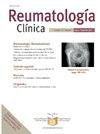高海拔安第斯地区类风湿关节炎患者心血管风险评分的一致性
IF 1.2
Q4 RHEUMATOLOGY
引用次数: 0
摘要
本研究旨在评估类风湿关节炎(RA)患者心血管风险评分之间的一致性。方法:我们于2024年在秘鲁库斯科的国家阿道夫格瓦拉贝拉斯科医院对成年RA患者进行了横断面研究。使用2019年世界卫生组织心血管风险评分(2019- who - crs)、弗雷明汉风险评分(FRS)和类风湿关节炎扩展心血管风险预测评分(ERS-RA)来估计心血管疾病的10年风险。通过Bland-Altman图和Kappa统计来评估一致性。结果共纳入145例患者。中位年龄为56岁(47-65岁),92%为女性。使用2019-WHO-CRS的中位评分为3% (2-5),FRS为5.4% (2.8-7.9),ERS-RA为5%(2.3-9.4)。以10%为截断点,2019-WHO-CRS、FRS和ERS-RA的心血管高危患者比例分别为7.6%、16.7%和23.2%。在Bland-Altman图中,风险评分之间的一致性界限很大(2019-WHO-CRS与ERS-RA的一致性界限为- 16.8%至1.4%,2019-WHO-CRS与FRS的一致性界限为- 12.8%至2.3%,FRS与ERS-RA的一致性界限为- 11.8%至7.7%)。2019-WHO-CRS评分与FRS评分在预测高风险方面的一致性最高(Kappa统计值:0.56)。我们的研究结果表明,在安第斯地区患有RA的人群中,2019-WHO-CRS、FRS和ERS-RA心血管风险评分存在差异。结论各评分对心血管高危患者的识别差异较大,ERS-AR评分最高。需要进一步的前瞻性研究来评估这些评分的预后表现。本文章由计算机程序翻译,如有差异,请以英文原文为准。
Agreement between cardiovascular risk scores in a high-altitude Andean population with rheumatoid arthritis
Background
This study aimed to assess the agreement between cardiovascular risk scores in patients with rheumatoid arthritis (RA).
Methods
We conducted a cross-sectional study of adult patients with RA at the Hospital Nacional Adolfo Guevara Velasco in Cusco-Peru in 2024. The 2019 World Health Organization cardiovascular risk score (2019-WHO-CRS), Framingham risk score (FRS), and Expanded cardiovascular Risk prediction Score for Rheumatoid Arthritis (ERS-RA) were used to estimate the 10-year risk of cardiovascular disease. Agreement was assessed through Bland–Altman plots and Kappa statistics.
Results
A total of 145 patients were included. The median age was 56 years (47–65) and 92% were female. The median scores using the 2019-WHO-CRS was 3% (2–5), FRS was 5.4% (2.8–7.9), and ERS-RA was 5% (2.3–9.4). Using a cut-off point >10%, the proportion of patients with high cardiovascular risk was 7.6%, 16.7%, and 23.2% for 2019-WHO-CRS, FRS, and ERS-RA, respectively. In the Bland–Altman plots, the limits of agreement were wide between risk scores (−16.8% to 1.4% for 2019-WHO-CRS vs. ERS-RA, −12.8% to 2.3% for 2019-WHO-CRS vs. FRS, and −11.8% to 7.7% for FRS vs. ERS-RA). The highest agreement (Kappa statistic: 0.56) in predicting high risk was between 2019-WHO-CRS and FRS scores. Our results suggest that there was disagreement between the 2019-WHO-CRS, FRS, and ERS-RA cardiovascular risk scores in an Andean population with RA.
Conclusion
The identification of patients at high cardiovascular risk varied considerably among the scores, with the ERS-AR yielding the highest values. Further prospective studies evaluating the prognostic performance of these scores are needed.
求助全文
通过发布文献求助,成功后即可免费获取论文全文。
去求助
来源期刊

Reumatologia Clinica
RHEUMATOLOGY-
CiteScore
2.40
自引率
6.70%
发文量
105
审稿时长
54 days
期刊介绍:
Una gran revista para cubrir eficazmente las necesidades de conocimientos en una patología de etiología, expresividad clínica y tratamiento tan amplios. Además es La Publicación Oficial de la Sociedad Española de Reumatología y del Colegio Mexicano de Reumatología y está incluida en los más prestigiosos índices de referencia en medicina.
 求助内容:
求助内容: 应助结果提醒方式:
应助结果提醒方式:


